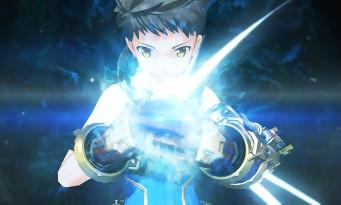 If you're not a series purist, don't worry, Monolith Software has made Xenoblade Chronicles 2 take you by the hand so you don't get lost. For fans, this also means that we will not find much from previous episodes, except for this particular artistic direction as well as a very large part of the bestiary directly imported from the first Xenoblade Chronicles. Fans of wild Lapix and Stiques will therefore be able to slaughter and farm on their favorite targets, all without feeling out of place. In Xenoblade Chronicles 2, no Mekon on the horizon, Monolith Software having preferred to start from scratch to create a universe that is still as enchanting but completely new. Welcome to Alrest, a world drowned in a sea covered with clouds and populated by the Titans, gigantic creatures sheltering civilization on the emerged part of their anatomy. Human Nopons and many other races therefore live on the backs of these disproportionate beings that make up the different continents of the world of Alrest. In this gigantic world, the player embodies Rex, a diver who earns his living by going to collect the vestiges of ancient civilizations lying at the bottom of the water, and which have become treasures over time. The hero is accompanied by grandpa, a small titan who is content to swim in the sea, and who hosts his host and friend in a symbiotic and friendly relationship that smells of Japanese tradition. Unfortunately, the Titans are dying, which dooms civilization in the long run. The only hope is the tree of life, a kind of earthly paradise and unique eternal structure that floats above the waves. If the pitch already makes you think of the film Waterworld with Kevin Costner, know that the story deviates from it after a few hours of play thanks to the meeting between Rex and Pyra, a mythical blade nicknamed Ageis.
If you're not a series purist, don't worry, Monolith Software has made Xenoblade Chronicles 2 take you by the hand so you don't get lost. For fans, this also means that we will not find much from previous episodes, except for this particular artistic direction as well as a very large part of the bestiary directly imported from the first Xenoblade Chronicles. Fans of wild Lapix and Stiques will therefore be able to slaughter and farm on their favorite targets, all without feeling out of place. In Xenoblade Chronicles 2, no Mekon on the horizon, Monolith Software having preferred to start from scratch to create a universe that is still as enchanting but completely new. Welcome to Alrest, a world drowned in a sea covered with clouds and populated by the Titans, gigantic creatures sheltering civilization on the emerged part of their anatomy. Human Nopons and many other races therefore live on the backs of these disproportionate beings that make up the different continents of the world of Alrest. In this gigantic world, the player embodies Rex, a diver who earns his living by going to collect the vestiges of ancient civilizations lying at the bottom of the water, and which have become treasures over time. The hero is accompanied by grandpa, a small titan who is content to swim in the sea, and who hosts his host and friend in a symbiotic and friendly relationship that smells of Japanese tradition. Unfortunately, the Titans are dying, which dooms civilization in the long run. The only hope is the tree of life, a kind of earthly paradise and unique eternal structure that floats above the waves. If the pitch already makes you think of the film Waterworld with Kevin Costner, know that the story deviates from it after a few hours of play thanks to the meeting between Rex and Pyra, a mythical blade nicknamed Ageis.
THE SOUL OF BLADES
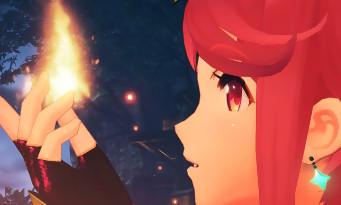 In Xenoblade Chronicles 2, the blades are a biomechanical entity that brings together a being (with a humanoid or animal appearance) and a weapon (which can be a sword, a hammer, or even a gun). The blades are locked in heart-crystals which can be opened by certain people called pilots. Rex will therefore find himself in this role, while the interaction between a pilot and his blades becomes one of the central points of a rather well-crafted scenario, and of which nothing will be said to avoid spoilers. Just know that Monolith Software has managed a difficult alchemy between periods of exploration, main missions and cutscenes that allow the player to find out more. Moreover, if these cut scenes are numerous and rich in lessons, we regret their great similarity since the latter very often call for a simple dialogue between several characters a little too academic. Accompanied by other pilots, Rex will live multiple adventures in the purest JRPG style, the whole being even sprinkled with ecchi touches since Pyra (like other blades) takes the form of a pretty young lady with disproportionate breasts and thong -minimalist twine. We note, in passing, that among the additional interactions that we must unearth to increase our understanding with our teammates, we have spotted more than one that surfs on these ribald themes. These light passages are one of the reasons we recommend using the Japanese voices (downloadable separately and free from the eShop), as all voice acting is done by heavily accented British actors. . Difficult to immerse yourself in the offbeat atmosphere when the character speaks with an accent from Manchester, London, Wales or even Ireland, all the more so when the characters all have traits from the universe manga as it is.
In Xenoblade Chronicles 2, the blades are a biomechanical entity that brings together a being (with a humanoid or animal appearance) and a weapon (which can be a sword, a hammer, or even a gun). The blades are locked in heart-crystals which can be opened by certain people called pilots. Rex will therefore find himself in this role, while the interaction between a pilot and his blades becomes one of the central points of a rather well-crafted scenario, and of which nothing will be said to avoid spoilers. Just know that Monolith Software has managed a difficult alchemy between periods of exploration, main missions and cutscenes that allow the player to find out more. Moreover, if these cut scenes are numerous and rich in lessons, we regret their great similarity since the latter very often call for a simple dialogue between several characters a little too academic. Accompanied by other pilots, Rex will live multiple adventures in the purest JRPG style, the whole being even sprinkled with ecchi touches since Pyra (like other blades) takes the form of a pretty young lady with disproportionate breasts and thong -minimalist twine. We note, in passing, that among the additional interactions that we must unearth to increase our understanding with our teammates, we have spotted more than one that surfs on these ribald themes. These light passages are one of the reasons we recommend using the Japanese voices (downloadable separately and free from the eShop), as all voice acting is done by heavily accented British actors. . Difficult to immerse yourself in the offbeat atmosphere when the character speaks with an accent from Manchester, London, Wales or even Ireland, all the more so when the characters all have traits from the universe manga as it is.
The great strength of this Xenoblade Chronicles 2 is undeniably its combat system which builds its foundations on a simple base, before adding many subtleties.
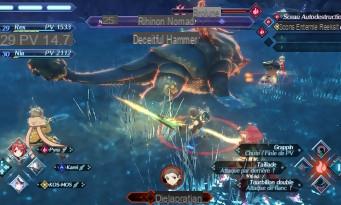 The great strength of this Xenoblade Chronicles 2 is undeniably its combat system which builds its foundations on a simple base, before adding many subtleties. Typically, your team of three fighters mixes three classes. First of all, there is the Tank which strikes quickly, attracts monsters, inflicts little damage, and has a monumental defense. Then comes the Medic who, despite his weakness in attacks, has a good defense and can heal his team members. Finally, the Attacker (or DPS) is there to hurt by typing with a low cadence, it's true, but by inflicting very heavy damage. Contrary to custom, this role will not be determined by the character, but by its blade since it is to it that all combat statistics are linked, the level of your character acting a bit like a multiplier. Nothing therefore prevents the player from embodying a Medic or a Tank, even if the story places him in the role of the DPS. In combat, the player will therefore target a single enemy, while the attack will be done automatically once the latter is within range and when you are stationary - yes, you cannot attack while moving). Each hit will fill the Pilots Arts gauge which allows you to trigger three specific attacks linked to your blade. The latter grant a damage bonus when they hit a particular area (from behind, on the flank), or can confer specific states on enemies (fall, destabilized, immobilized, etc.). Each Art used will also allow you to recharge the Ultimate Art gauge, knowing that a good sense of timing can help regenerate this special move more quickly. The Ultimate Art is specific in that it has four levels that will trigger different attacks, and whose damage will also vary depending on your dexterity in performing a small QTE. Each blade has its own element (as in Pokémon), which implies that its Ultimate Art will be of this element, fire in the case of Pyra.
The great strength of this Xenoblade Chronicles 2 is undeniably its combat system which builds its foundations on a simple base, before adding many subtleties. Typically, your team of three fighters mixes three classes. First of all, there is the Tank which strikes quickly, attracts monsters, inflicts little damage, and has a monumental defense. Then comes the Medic who, despite his weakness in attacks, has a good defense and can heal his team members. Finally, the Attacker (or DPS) is there to hurt by typing with a low cadence, it's true, but by inflicting very heavy damage. Contrary to custom, this role will not be determined by the character, but by its blade since it is to it that all combat statistics are linked, the level of your character acting a bit like a multiplier. Nothing therefore prevents the player from embodying a Medic or a Tank, even if the story places him in the role of the DPS. In combat, the player will therefore target a single enemy, while the attack will be done automatically once the latter is within range and when you are stationary - yes, you cannot attack while moving). Each hit will fill the Pilots Arts gauge which allows you to trigger three specific attacks linked to your blade. The latter grant a damage bonus when they hit a particular area (from behind, on the flank), or can confer specific states on enemies (fall, destabilized, immobilized, etc.). Each Art used will also allow you to recharge the Ultimate Art gauge, knowing that a good sense of timing can help regenerate this special move more quickly. The Ultimate Art is specific in that it has four levels that will trigger different attacks, and whose damage will also vary depending on your dexterity in performing a small QTE. Each blade has its own element (as in Pokémon), which implies that its Ultimate Art will be of this element, fire in the case of Pyra.
PYRA FEU
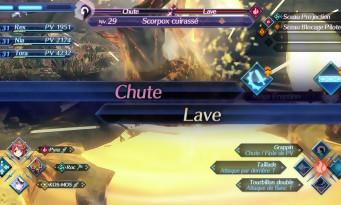 However, by mixing various elements and states, it will be possible to achieve an incredible number of more or less devastating combos, depending on the enemy's weaknesses in fire, water or earth. Thus, by activating the Tank's Ultimate Earth Art before using Pyra's fire attack, we will be able to slam a combo that will cause a stream of lava to spurt out from under the enemy's feet. Better, by making the enemy fall at this precise moment, we can still maximize the effect of the attack a little more. In short, you have understood, the possibilities are endless, especially since each pilot can take three different blades into battle, for a total of nine elements at your disposal to achieve increasingly crazy combos. As we said earlier, the blades are obtained by opening heart-crystals that randomly grant this or that weapon, knowing that there are many different ones with several levels of quality. Exceptional blades have a much sleeker character design, as well as much more interesting statistics. In order to maximize the obtaining of these, it will therefore be necessary to focus on the best quality crystals and to allocate the available boosters to them, although the result is never guaranteed. Each blade can then be individually improved via a table which explains how to obtain new skills (actions to be carried out in combat most often), or via the use of consumable crystals which radically change the statistics. Additionally, each blade has one or more slots to store Refined Cores to enhance their effectiveness. This very free system offers the advantage of being able to shape your blades according to your good will, but the other side of the coin is that you will have to spend a lot of time in the various menus and sub-menus in order to optimize everything.
However, by mixing various elements and states, it will be possible to achieve an incredible number of more or less devastating combos, depending on the enemy's weaknesses in fire, water or earth. Thus, by activating the Tank's Ultimate Earth Art before using Pyra's fire attack, we will be able to slam a combo that will cause a stream of lava to spurt out from under the enemy's feet. Better, by making the enemy fall at this precise moment, we can still maximize the effect of the attack a little more. In short, you have understood, the possibilities are endless, especially since each pilot can take three different blades into battle, for a total of nine elements at your disposal to achieve increasingly crazy combos. As we said earlier, the blades are obtained by opening heart-crystals that randomly grant this or that weapon, knowing that there are many different ones with several levels of quality. Exceptional blades have a much sleeker character design, as well as much more interesting statistics. In order to maximize the obtaining of these, it will therefore be necessary to focus on the best quality crystals and to allocate the available boosters to them, although the result is never guaranteed. Each blade can then be individually improved via a table which explains how to obtain new skills (actions to be carried out in combat most often), or via the use of consumable crystals which radically change the statistics. Additionally, each blade has one or more slots to store Refined Cores to enhance their effectiveness. This very free system offers the advantage of being able to shape your blades according to your good will, but the other side of the coin is that you will have to spend a lot of time in the various menus and sub-menus in order to optimize everything.
DORA THE EXPLORER
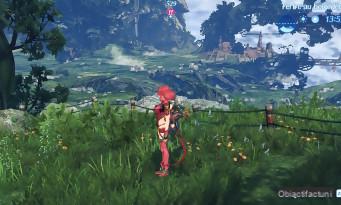 The only exception to this system, our Tank has an artificial blade (a kind of robot) which is, for its part, fully configurable. You can change absolutely everything, from your weapons to your statistics, which you can change individually. The problem is that you have to collect special gems by playing Tiger-Tiger, a vertical scrolling video game available in the house of its builder. However, even by achieving good scores, the reward remains very limited, which forces you to spend whole hours scoring on this mini-game which very quickly becomes horrifying. As a result, we end up dropping the improvement of this artificial blade, and we prefer to increase our firepower via XP and character level. Fortunately, the other great strong point of Xenoblade Chronicles 2 remains of course its rich environment, especially when we are on the Titan Gormott which offers green meadows to our amazed peepers. Exploration plays a major role here, whether to get your hands on new material deposits or on points allowing you to dive (and recover loot), to discover secret areas, or simply to farm. killing local wildlife. On this point, we are delighted to tell you that the legendary beasts are renewed in order to spice up your walks a little more as well as the end of the game, since we can resuscitate them. For novices, be aware that these monsters are enemies that are much harder to kill than their level suggests, and which offer a significant loot once defeated. Unfortunately, if the game always shows us the level of NPCs when we approach them (in order to avoid attacking a level 90 monster at the start of the game, for example), the hostility indicator has completely gone. It is now impossible to know if a critter wandering around will watch you wander around indifferently, or if it will decide to bite you, which can be problematic as some high level creatures can kill you easily from one shot.
The only exception to this system, our Tank has an artificial blade (a kind of robot) which is, for its part, fully configurable. You can change absolutely everything, from your weapons to your statistics, which you can change individually. The problem is that you have to collect special gems by playing Tiger-Tiger, a vertical scrolling video game available in the house of its builder. However, even by achieving good scores, the reward remains very limited, which forces you to spend whole hours scoring on this mini-game which very quickly becomes horrifying. As a result, we end up dropping the improvement of this artificial blade, and we prefer to increase our firepower via XP and character level. Fortunately, the other great strong point of Xenoblade Chronicles 2 remains of course its rich environment, especially when we are on the Titan Gormott which offers green meadows to our amazed peepers. Exploration plays a major role here, whether to get your hands on new material deposits or on points allowing you to dive (and recover loot), to discover secret areas, or simply to farm. killing local wildlife. On this point, we are delighted to tell you that the legendary beasts are renewed in order to spice up your walks a little more as well as the end of the game, since we can resuscitate them. For novices, be aware that these monsters are enemies that are much harder to kill than their level suggests, and which offer a significant loot once defeated. Unfortunately, if the game always shows us the level of NPCs when we approach them (in order to avoid attacking a level 90 monster at the start of the game, for example), the hostility indicator has completely gone. It is now impossible to know if a critter wandering around will watch you wander around indifferently, or if it will decide to bite you, which can be problematic as some high level creatures can kill you easily from one shot.
[...] once again, the Nintendo Switch fishes by its power by showing here a clipping of an incredible violence.
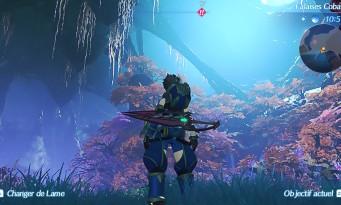 This is a disadvantage not to be underestimated because, once again, the Nintendo Switch sins by its power with an incredibly violent clipping. It is therefore not uncommon to see an animal appear right before our eyes to the point that we cannot avoid the fight. The console clearly suffers, and if we pass on the fairly present aliasing, it is more difficult to forgive the big framerate drops in the middle of a fight as soon as several enemies enter the dance. With six bellicose NPCs, an open environment, and effects everywhere, the machine immediately gives up, turning smooth animation into a veritable slideshow. Fortunately, most of the time, we can attract opponents to face them one by one to avoid these inconveniences. Exploration in itself allows you to gain XP, since if the points earned during the fights are immediately counted, all that is obtained via the side missions and the discovery of new areas of the map can only be received after having taken a nap in the nearest hostel. This mechanism allows the most hardcore players to limit their progress, and to be able to grind more than reason. We must also mention the incredible Xenoblade Chronicles soundtrack that accompanies each of our trips. Even if the game suffers from audio mixing problems - especially during cutscenes where the music stifles the voices - the themes played are more often a source of happiness than frustration. Good news considering that the adventure takes about 80 hours to complete, or even longer if you want to complete each side quest and explore every corner of each Alrest Titan. In addition, DLC being planned, the game should not gather dust for a while.
This is a disadvantage not to be underestimated because, once again, the Nintendo Switch sins by its power with an incredibly violent clipping. It is therefore not uncommon to see an animal appear right before our eyes to the point that we cannot avoid the fight. The console clearly suffers, and if we pass on the fairly present aliasing, it is more difficult to forgive the big framerate drops in the middle of a fight as soon as several enemies enter the dance. With six bellicose NPCs, an open environment, and effects everywhere, the machine immediately gives up, turning smooth animation into a veritable slideshow. Fortunately, most of the time, we can attract opponents to face them one by one to avoid these inconveniences. Exploration in itself allows you to gain XP, since if the points earned during the fights are immediately counted, all that is obtained via the side missions and the discovery of new areas of the map can only be received after having taken a nap in the nearest hostel. This mechanism allows the most hardcore players to limit their progress, and to be able to grind more than reason. We must also mention the incredible Xenoblade Chronicles soundtrack that accompanies each of our trips. Even if the game suffers from audio mixing problems - especially during cutscenes where the music stifles the voices - the themes played are more often a source of happiness than frustration. Good news considering that the adventure takes about 80 hours to complete, or even longer if you want to complete each side quest and explore every corner of each Alrest Titan. In addition, DLC being planned, the game should not gather dust for a while.


























